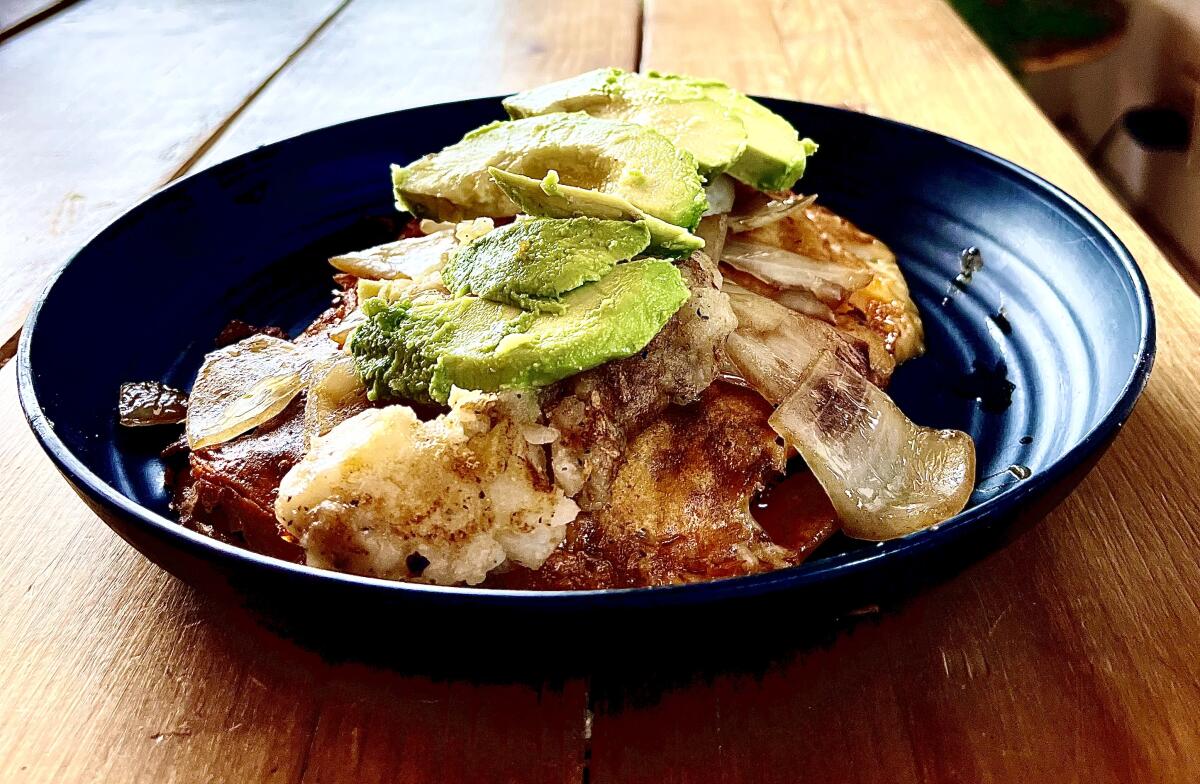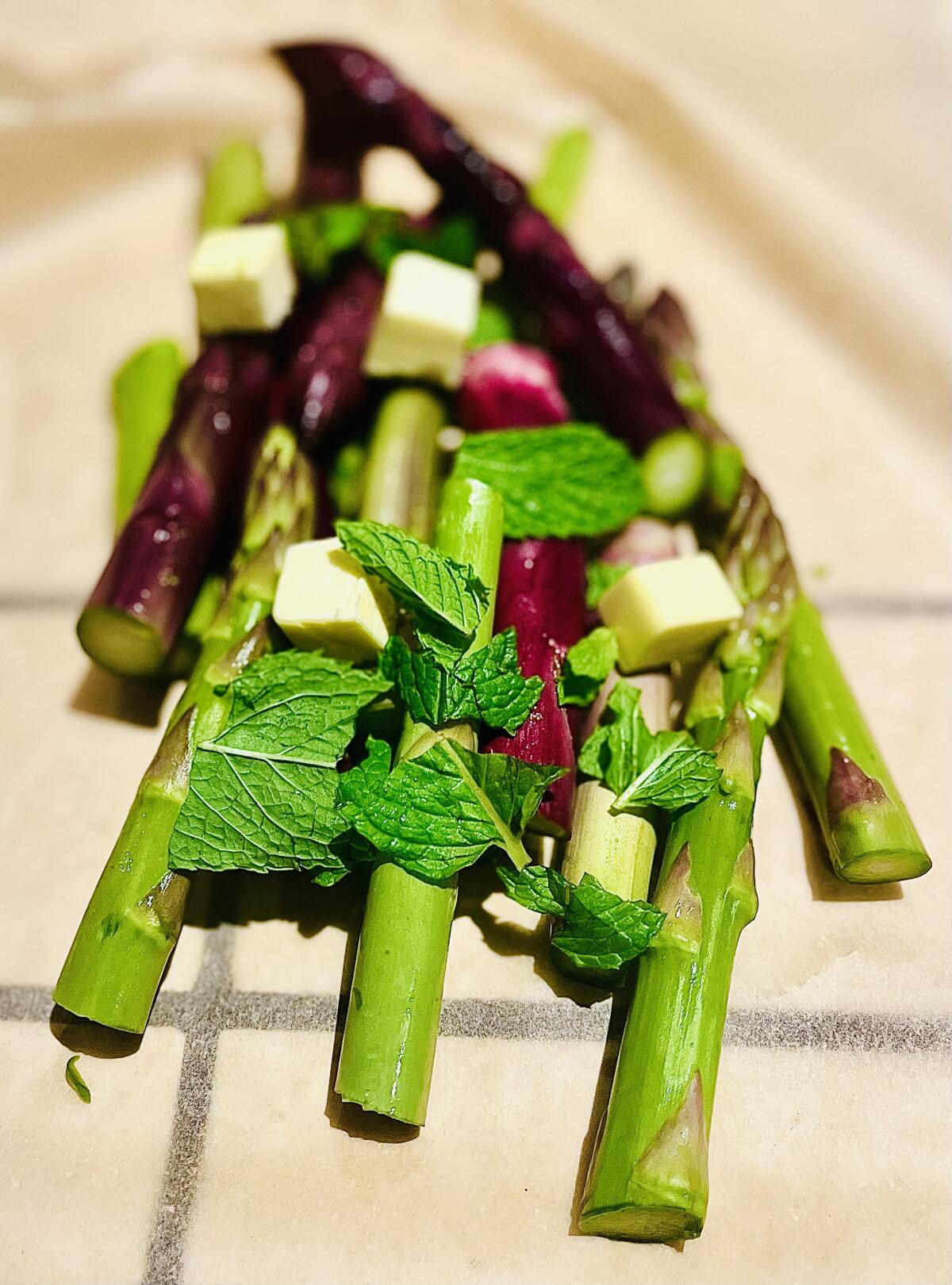Sometimes Mom really does know best

(Laurie Ochoa / Los Angeles Times)
I’m sure I’m not the only daughter who has suppressed an eye roll when her mother says she’s found a new restaurant I should check out. Maybe a friend of a friend’s cousin has opened a new place. Or she wants to know if I’ve heard about the Armenian tacos featured on “Good Day L.A.” … more than six months after I wrote about the restaurant’s founder, Armen Martirosyan, for this paper and three months after my colleague Stephanie Breijo wrote a detailed report about the opening of MidEast Tacos.
But there are times you have to quiet your inner brat and listen to your mother. So when my mom said she and her friend Pablo had eaten fantastic chilaquiles at a new place in Pico Rivera, I paid attention.
I was raised on the best Mexican breakfasts. My mom’s crumbled chorizo, over-easy eggs, cheesy refried beans and flour tortillas were how our weekends usually began. Often, this would be one of the few times my sister, mother and I would come together as a team, mashing cheese into the beans, learning to heat the tortillas directly on the burner without burning our fingers, feeling the satisfaction of breaking the casing on the lengths of chorizo and releasing the brick-red bits of pork. My mom was usually in charge of the eggs, but sometimes she’d let us practice flipping them over. And if we broke the yolk, there was always another egg offered to try again.
Sometimes there would be pan dulce too — of all the Mexican sweet bread varieties, chocolate-dusted conchas and the gingerbread pigs called puerquitos are still my favorites. When my grandmother was alive, we’d have her homemade menudo on special occasions — it’s the reason I came to love tripe in all its forms, especially Roman-style tripe with tomato sauce and pecorino or delicate chile-spiked tendrils of tripe from the carts dim sum servers are reluctant to open for non-Chinese customers.
It was a rainy day when I brought my son and daughter to meet my mom and Pablo at Taquearte California off Rosemead Boulevard, not far from my mother’s alma mater El Rancho High School. The taquería is attached to Duran’s Bakery, a pan dulce and tamale specialist that opened in 1980 and until January was run by the Duran family.
The contrast was clear between the old-school bakery and the newer plant-filled taquería with a neon Taquearte sign on gleaming subway tile, an Atomic Age-style light fixture hanging from a modern wood-slat ceiling and the hiss of a cappuccino machine. Most of the polished-wood picnic tables inside were filled and there was a line at the counter, so while some of us waited to place our order I went to the adjacent bakery and bought some of Duran’s conchas for later.
A table at Taquearte opened up and when the food started to appear I realized my mother knew what she was talking about. She was even recognized as a regular by the young, hip server, who treated her like a VIP.
The chilaquiles at Taquearte are all about the sauces and the layering. If you get eggs with your order, sunny-side-up or over-easy, the softened tortilla chips beneath likely will be hidden, with a hint of the meat of your choice — steak, chicken, pork chop or chorizo — nestled beside the eggs on top.
When you dig in, letting the yolk of the egg ooze its way through the layers as you eat, you find a range of flavors and textures. Some of the chips on the outer band of the bowl remain crisp, and there’s satisfaction when you reach the soft center with crumbled cheese throughout. If you’ve ordered your chilaquiles divorciados style — with both red and green sauces — there are even more flavors to explore as the separate sauces come together.
Yet another layer of flavor comes from one or more of the salsas brought to the table in a row of small bowls, an earth-tone spectrum of color and spice levels. It’s no surprise that taco maven Bill Esparza agrees with my mom and declared in Eater that Taquearte’s chilaquiles are the best in Los Angeles.
If you time your visit right, you can eat your chilaquiles for breakfast and then, if you linger until noon, add a taco to share. And you will have to share if you’ve been eating chilaquiles because these aren’t tiny tacos.
Two open-faced tortillas — or one larger tortilla, depending on how the cooks are feeling in the still-evolving kitchen — are loaded, Mexico City-style, with baked potato and caramelized onion along with the meat you’ve chosen and, if you like, sliced avocado. It’s so unwieldy it’s served in a bowl.

A loaded taco at Taquearte California in Pico Rivera.
(Laurie Ochoa / Los Angeles Times)
“Is that a taco?” my son asked.
Our wise server smiled and had a simple answer: “It’s a masterpiece.”
California’s disappearing asparagus

Fourth-generation farmer Aaron Barcellos of A-Bar Ag Enterprises in Firebaugh, one of just three large-scale asparagus farming operations left in California.
(Allen J. Schaben/Los Angeles Times)
For many of us longtime farmers market shoppers, one of the happiest signs of spring, as former Times food editor Russ Parsons wrote in 2013, was the appearance of jumbo asparagus spears from Zuckerman Farms. But in recent years, Zuckerman’s asparagus has been a no-show. The farm still grows some asparagus, but not enough of it to make its way to our farmers markets.
Back in 2004, Parsons wrote a prescient story about how global trade and the delicate nature of asparagus, “which demands as much hand cultivation and as careful harvesting as the grapes for some rare wine,” was threatening the asparagus industry. Twenty years later, reporter Cindy Carcamo found that the situation has only gotten worse. Things are so bad that only three large-scale conventionally farmed asparagus operations remain in California.
“Every spear of asparagus you see in the store is hand-cut by an individual,” said Aaron Barcellos, who runs A-Bar Ag Enterprises, one of those three asparagus growers.
“At its most recent peak in 2000,” Carcamo wrote, “California farmers harvested 37,000 acres of asparagus, according to the state Department of Food and Agriculture. About 10% of that acreage has been lost every year since. Now there are fewer than 3,000 acres of asparagus left in the Golden State, according to the latest available data.”
In place of meatier California-grown asparagus at our supermarkets, we’re seeing more of the woodier, twig-thin spears grown in Mexico. But this past weekend, I was able to find meaty California-grown asparagus in three local markets: Whole Foods in Pasadena, Howie’s in San Marino and Taylor’s Ol’ Fashioned Market in Sierra Madre.

California-grown asparagus.
(Laurie Ochoa / Los Angeles Times)
Under the Peacock label, which comes from Barcellos’ A-Bar Ag Enterprises, there were bundles of purple asparagus as well as green. And there was organic asparagus from Durst, one of the smaller farms still growing the crop.
In tomorrow’s cooking newsletter — which you can subscribe to here — Carcamo writes about how reporting on the asparagus story gave her a new appreciation for the vegetable. She also gives tips from a pro on what to look for when buying asparagus plus four excellent recipes from our archives.
I have my own favorite way of cooking asparagus, a method I picked up from Nancy Silverton‘s “Chi Spacca” cookbook. You dot asparagus with butter and mint leaves, then wrap the spears in parchment paper and bake in a 450-degree oven for 10 to 15 minutes, depending on the thickness of the asparagus. Then you open the packages, sprinkle the asparagus with your favorite finishing salt and pepper, and grate Parmesan on top. The recipe worked beautifully with my three types of California asparagus — a spring feast with a quick-cooking rack of lamb.

An assortment of California-grown asparagus with mint and butter about to be bundled in parchment and roasted in the oven.
(Laurie Ochoa / Los Angeles Times)
More spring cooking: Last week’s cooking newsletter guest written by The Times’ head of newsletters, Karim Doumar, presented an Orthodox Easter feast, but the recipes — including the Jordanian lamb dish mansaf, the flatbread mana’esh with za’atar and the toasted pita salad fattoush — are worth saving for any time of the year.
Newsletter
You’re reading Tasting Notes
Our L.A. Times restaurant experts share insights and off-the-cuff takes on where they’re eating right now.
You may occasionally receive promotional content from the Los Angeles Times.
Awards season

Partners Nikki Reginaldo, left, chef Jon Yao and Ryan Bailey outside their restaurant Kato at Row DTLA.
(Mariah Tauger / Los Angeles Times)
If winter is Oscar season, late spring brings some of the food world’s most-watched awards. At the James Beard Awards, coming June 8 and 10 in Chicago, Kuya Lord‘s Lord Maynard Llera is up for California best chef, Long Beach’s Gusto Bread is up for outstanding bakery and Anaheim tiki bar Strong Water is a finalist in the contest for outstanding wine and other beverages program. Last week we got news that Times food editor Daniel Hernandez is a nominee in the dining and travel category of the Beards’ Media Awards for his feature on Mexico City’s changing food scene.
And, as Jenn Harris reported this week, “For the first time in more than a decade, the World’s 50 Best Restaurants will recognize a Los Angeles restaurant with an award. Downtown L.A.’s Kato, the No. 1 restaurant on Times critic Bill Addison‘s most recent 101 Best Restaurants in Los Angeles guide, will receive the 2024 Resy One to Watch award at the 50 Best ceremony, which will be held at the Wynn Las Vegas on June 5. The Wynn is also hosting a food festival around the 50 Best awards, which will be a gathering of the world’s most acclaimed chefs. Revelry will not only include dinners and demonstrations from international chefs, but several Southern California chefs, including a master class and tasting with Yakitoriguy, who was profiled in the Times recently by Stephanie Breijo.
Also …
Newsletter
Eat your way across L.A.
Like what you’re reading? Sign up to get it in your inbox every week.
You may occasionally receive promotional content from the Los Angeles Times.

